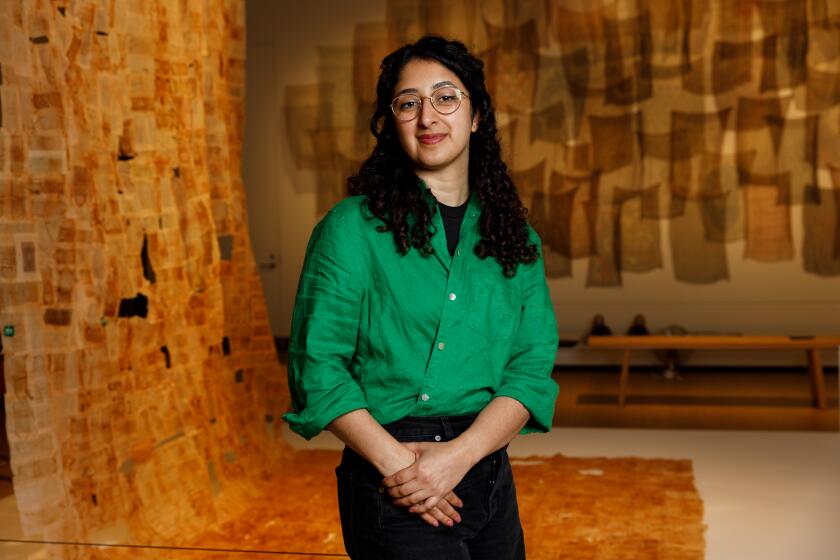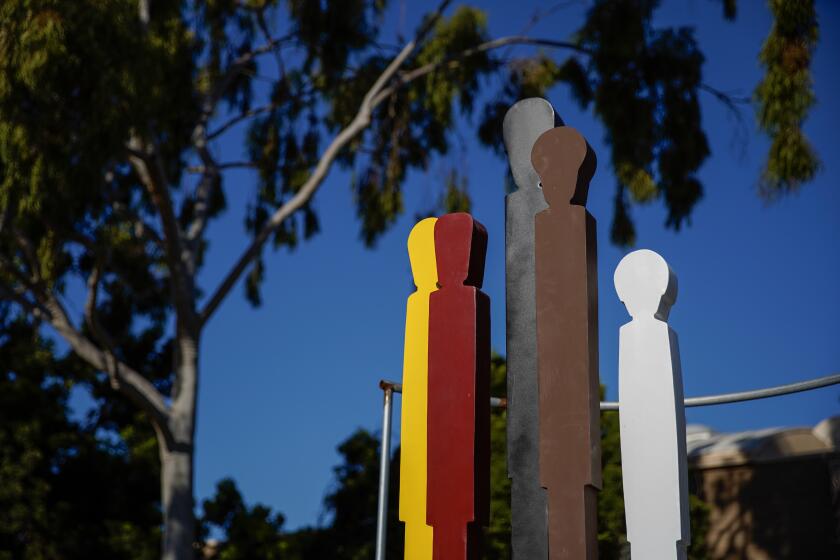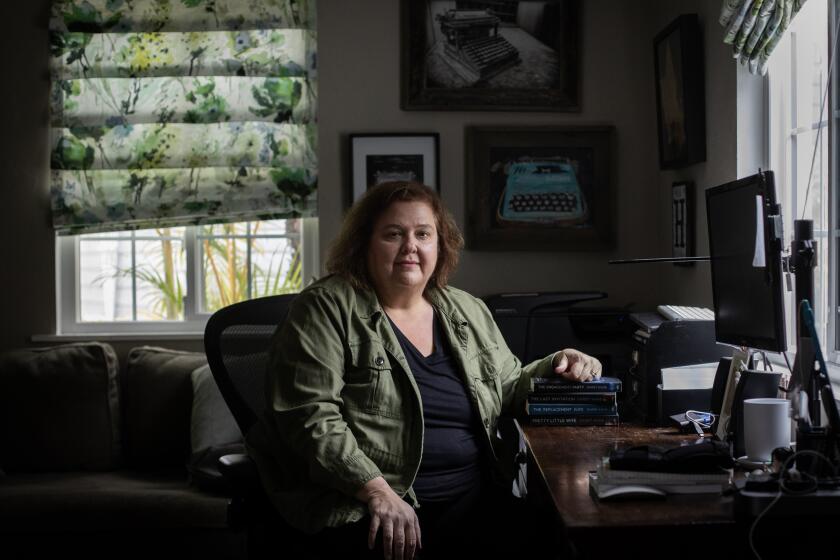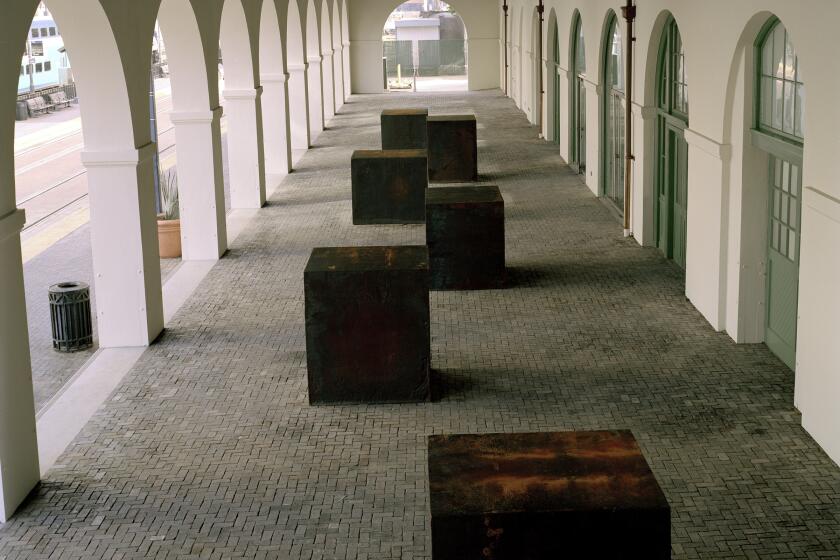Is architect Irving J. Gill the missing modernist?
In 1916 — more than a decade before the master of minimalism, Ludwig Mies van der Rohe, would start construction on Villa Tugendhat in the Czech Republic and 40 years before Los Angeles architect Pierre Koenig would hang a glass box over the Hollywood Hills in the celebrated Stahl House — Irving J. Gill was designing a home in La Jolla for Ellen Browning Scripps. It had creamy white walls, bold geometric forms and an upper-story glass sunroom floating high above the rugged coastline.
Today that sunroom is a gallery in the Museum of Contemporary Art San Diego (MCASD), home to Robert Irwin’s iconic artwork, “1°2°3°4°,” a conceptual link in time to when Scripps watched the ocean from her perch.
“What we see now as clean-lined modernism was created by Gill in San Diego,” says James Guthrie, an architect himself and president and co-founder of the Irving J. Gill Foundation.
Guthrie has pulled together 14 organizations in a collaborative project, “Irving J. Gill: New Architecture for a Great Country.” It’s timed to coincide with Archtoberfest, a month-long celebration of architecture and design. The Gill portion includes nine exhibitions plus a symposium, tours, talks and publications.
“His work is internationally important and significant, architecturally speaking, especially when you know the history and timeline of modern architecture. He’s the No. 1 guy. He’s the one who started it,” says Guthrie, before adding, “If you pick up a book on modern architecture, he’s not in it. And so that needs to change.”
A few years ago, Guthrie learned that UC Santa Barbara was thinking about showing selections from its extensive archive of Gill’s photographs, renderings and letters. Guthrie initially considered bringing it to San Diego, but local groups wanted to do more — something that would quantify the depth of Gill’s influence, trigger new research and secure the architect’s place in history.
“In a broad sense, the reason it is this year is because all the stars that needed to align to make it happen did align. You can imagine, with all the organizations that are working on this, it took some doing to get everyone locked in,” Guthrie says. Coincidentally, 2016 is the 100th anniversary of the Scripps House and the now-demolished Dodge House, considered two of Gill’s best works.
Guthrie describes San Diego as Gill’s “petri dish,” where he established a vocabulary that he would later take with him to Los Angeles. The architect learned his early skills in Chicago as an apprentice under Joseph Silsbee and Louis Sullivan, when they were setting the pace for an American architecture, one that split from European tradition to reflect regional character.
Gill brought those ideas west in 1893. He embraced the Southern California topography and climate, creating designs that were a radical change from fussy Victorian homes on flat lots. He worked with the area’s natural canyons, recognizing them as a way to frame views and circulate air. He used concrete and stucco, materials now considered essential for fire safety. He opened up rooms to encourage outdoor living and incorporated technical advances like solar water heaters and whole-house vacuum systems.
This led to international acclaim and high-budget commissions — many of them from progressive, single women like Scripps. But the Great Depression brought a halt to custom homes and Gill’s profile dropped. Unlike Frank Lloyd Wright, who weathered the downturn by lecturing, publishing and opening Taliesin West, his Arizona architecture school, Gill preferred to work quietly. He died in 1936 at age 66, long before postwar economic resurgence revived the careers of the men who would become modernist stars.
“Gill was every bit as good an architect as Frank Lloyd Wright. He just wasn’t good at self-promotion,” says Guthrie. “He was much more interested in solving the architectural problem that he was dealing with at the moment.”
In the same way that engineers appreciate the structure of a Gill building while architects admire the aesthetics, each contributing organization brought its own perspective.
Marston House reflects Gill’s transitional period when he moved away from Arts and Crafts decoration and began to find ways to streamline. The exhibit at La Jolla Historical Society, curated by Kathryn Kanjo of MCASD, presents watercolors and sketches that reveal his gift for luminous color. The San Diego History Center exhibit, curated by Guthrie, traces Gill’s evolution from New York to Chicago to San Diego through photographs, artifacts, a documentary on the Dodge House and a model of Gill’s tilt-up concrete technique.
Barona Cultural Center & Museum hosts one of his final projects, a church and cottages developed for the Barona Indian Reservation. Barona allowed Gill to explore a personal interest: applying his principles of low-maintenance, healthy living to affordable housing. His simple shapes were intended to be replicated by the homeowners, who went on to make their own improvements.
That adaptability may be another reason why Gill was left out of the history books. As Guthrie notes, well-designed architecture becomes a background for your life — comfortable but taken for granted.
Gill’s innovations, once startling and avant-garde, have eased seamlessly into the landscape, because they were meant to fit here.
“What Gill did is now everywhere in San Diego. It is pretty ubiquitous. That’s one of the reasons why people don’t think of it as special — but it is,” says Guthrie.
“As San Diegans, we do take that for granted, but it’s very special in the world.”
“Irving J. Gill: New Architecture for a Great Country”
For more information, visit the Irving J. Gill Foundation website at irvingjgill.org
“Irving J. Gill: A Comfortable Fit” (Exhibition and tour):* Aug. 20-Oct. 23. Oceanside Museum of Art, 704 Pier View Way, Oceanside. $8. (760) 435-3720 or oma-online.org
“Irving J. Gill: Simplicity and Reform” (Exhibition): Sept. 10-Dec. 4. Art, Design & Architecture Museum at UC Santa Barbara, 552 University Road, Santa Barbara. Free. (805) 893-2951 or www.museum.ucsb.edu
“Stones in the Meadow” (Exhibition, workshops, tours and lecture):* Sept. 20-Indefinite. Barona Cultural Center & Museum, 1095 Barona Road, Lakeside. Free; reservations required. (619) 443-7003, Ext. 219 or baronamuseum.com/stones
“Irving J. Gill: New Architecture for a Great Country” (Exhibition): Sept. 24-March 31. San Diego History Center, 1649 El Prado, Suite #3, Balboa Park. $10. (619) 232-6203 or sandiegohistory.org
“Irving J. Gill: Illustrating New Architecture” (Exhibition and lecture):* Sept. 24-Jan. 22. La Jolla Historical Society and the Museum of Contemporary Art San Diego. Wisteria Cottage, 780 Prospect Street, La Jolla. Free for exhibit, fee for Nov. 12 lunch and talk. (858) 459-5335 or lajollahistory.org
“The Iannellis in California: Selected Works 1910-15” (Exhibition): Sept. 24-Nov. 5. Athenaeum Music & Arts Library, 1008 Wall Street, La Jolla. Free. (858) 454-5872 or ljathenaeum.org
“Irving Gill: Progress & Poetry in Architecture” (Exhibition and tours):* Sept. 24-March 26. Marston House, 3525 Seventh Ave., Balboa Park. $15. (619) 297-9327 or sohosandiego.org/main/marston2.htm
“Irving J. Gill, Coronado Refined” (Exhibition, lectures and tours): Oct. 1-April 1. Coronado Historical Association, 1100 Orange Ave., Coronado. Free admission, fee for lectures. (619) 435-7242 or coronadohistory.org
“Irving J. Gill and the Chicago School” (Symposium and tour):* 5 to 8:30 p.m. Oct. 20. La Jolla Woman’s Club, 7791 Draper Ave., La Jolla. Free. irvingjgill.org
“Romance and Honesty: Irving Gill’s Vision for The Bishop’s School” (Exhibition and tour):* 2 to 4 p.m. Oct. 29. The Bishop’s School, 7607 La Jolla Blvd., La Jolla. Free. (858) 875-0728 or bishops.com/page/irving-gill-
In addition, Save Our Heritage Organisation will hold tours and events from October to March. See sohosandiego.org for dates and ticket prices. For information on Archtoberfest events, go to archtoberfest.com.
*Denotes Gill-designed building
Get U-T Arts & Culture on Thursdays
A San Diego insider’s look at what talented artists are bringing to the stage, screen, galleries and more.
You may occasionally receive promotional content from the San Diego Union-Tribune.





